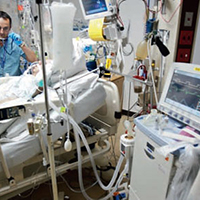Perception, experience and knowledge of early physiotherapy in intensive care units of Rome: a survey

Submitted: May 26, 2020
Accepted: September 18, 2020
Published: December 30, 2020
Accepted: September 18, 2020
Abstract Views: 2084
PDF: 1178
Supplementary: 127
Supplementary: 127
Publisher's note
All claims expressed in this article are solely those of the authors and do not necessarily represent those of their affiliated organizations, or those of the publisher, the editors and the reviewers. Any product that may be evaluated in this article or claim that may be made by its manufacturer is not guaranteed or endorsed by the publisher.
All claims expressed in this article are solely those of the authors and do not necessarily represent those of their affiliated organizations, or those of the publisher, the editors and the reviewers. Any product that may be evaluated in this article or claim that may be made by its manufacturer is not guaranteed or endorsed by the publisher.
Similar Articles
- Vasileios Gkogkos, Georgia-Emmanouela Dendrinou, Ioanna Papadaki, Maria Christodoulou, Charalampos Stoumpos, Timothy Sakellaridis, Kyriaki Zeibecoglou, Dimitrios Papadopoulos, Musculoskeletal tuberculosis with multifocal muscle abscesses in a healthy young adult , Monaldi Archives for Chest Disease: Vol. 93 No. 3 (2023)
- Georgi Yankov, Magdalena Alexieva, Nikolay Yanev, Evgeni Mekov, Two cases with postintubation tracheal stenosis after COVID-19 pneumonia , Monaldi Archives for Chest Disease: Vol. 93 No. 4 (2023)
- Despoina Moumtzi, Marianna Kakoura, Pulmonary embolism in Behcet's disease: a case report , Monaldi Archives for Chest Disease: Vol. 90 No. 4 (2020)
- Malay Sarkar, Irappa Madabhavi, Vocal resonance: a narrative review , Monaldi Archives for Chest Disease: Early Access
- Igor S. Mamenko, Igor V. Vasilev, Irina A. Tabanakova, Sultan M. Gasanmagomedov, Vera V. Sysoeva, Alexey D. Ushkov, Tatiana A. Novickaya, Piotr K. Yablonskii, Probe-based confocal laser endomicroscopy in diagnosis of desquamative interstitial pneumonia in nonsmoker , Monaldi Archives for Chest Disease: Vol. 89 No. 3 (2019)
- Matteo Gelardi, Giuseppe Porro, Vitaliano Quaranta, Nicola Quaranta, Michele Cassano, Giorgio Ciprandi, *Italian Study Group on CRSwNP, Clinical-Cytological-Grading and phenotyping in patients with chronic rhinosinusitis with nasal polyps: the relevance in clinical practice , Monaldi Archives for Chest Disease: Vol. 90 No. 2 (2020)
- Komaldeep Kaur, Aditi Gupta, Gagandeep Kaur, Vishal Chopra, Pleural effusion. An unfamiliar presentation of ABPA , Monaldi Archives for Chest Disease: Vol. 90 No. 4 (2020)
- Malay Sarkar, Irappa V. Madabhavi, Shailee Mehta, Swadeshkumar Mohanty, Use of flow volume curve to evaluate large airway obstruction , Monaldi Archives for Chest Disease: Vol. 92 No. 4 (2022)
- Nikhilesh Ladha, Pankaj Bhardwaj, Nishant Kumar Chauhan, Kikkeri Hanumantha Setty Naveen, Vijaya Lakshmi Nag, Dandabathula Giribabu, Determinants, risk factors and spatial analysis of multi-drug resistant pulmonary tuberculosis in Jodhpur, India , Monaldi Archives for Chest Disease: Vol. 92 No. 4 (2022)
- Anu Anna George, Kevin John John, Anil Jha, Ajay Kumar Mishra, Infections precipitating Takotsubo cardiomyopathy, an uncommon complication of a common infection , Monaldi Archives for Chest Disease: Vol. 93 No. 3 (2023)
<< < 109 110 111 112 113 114 115 116 117 118 > >>
You may also start an advanced similarity search for this article.

 https://doi.org/10.4081/monaldi.2020.1412
https://doi.org/10.4081/monaldi.2020.1412




